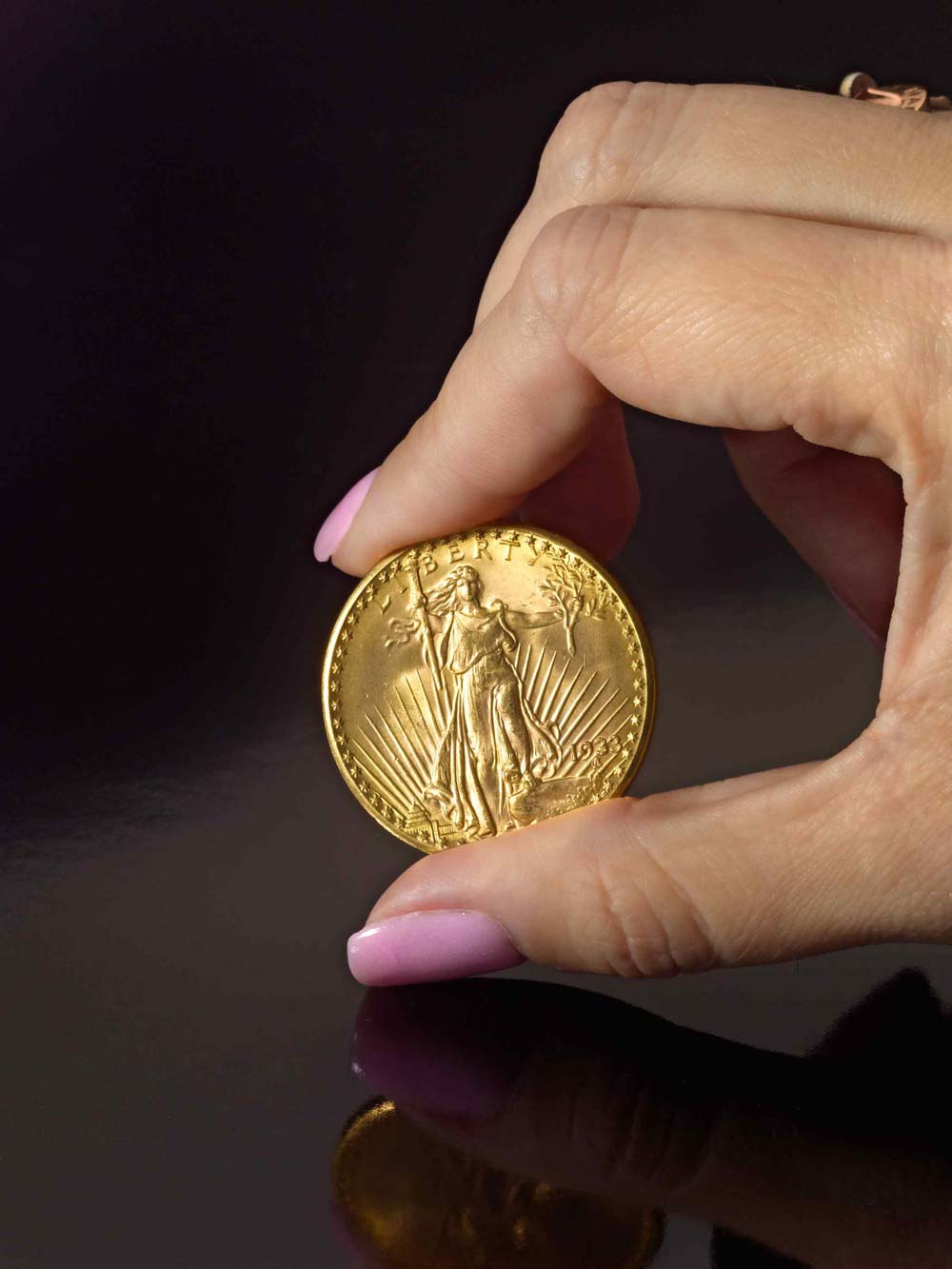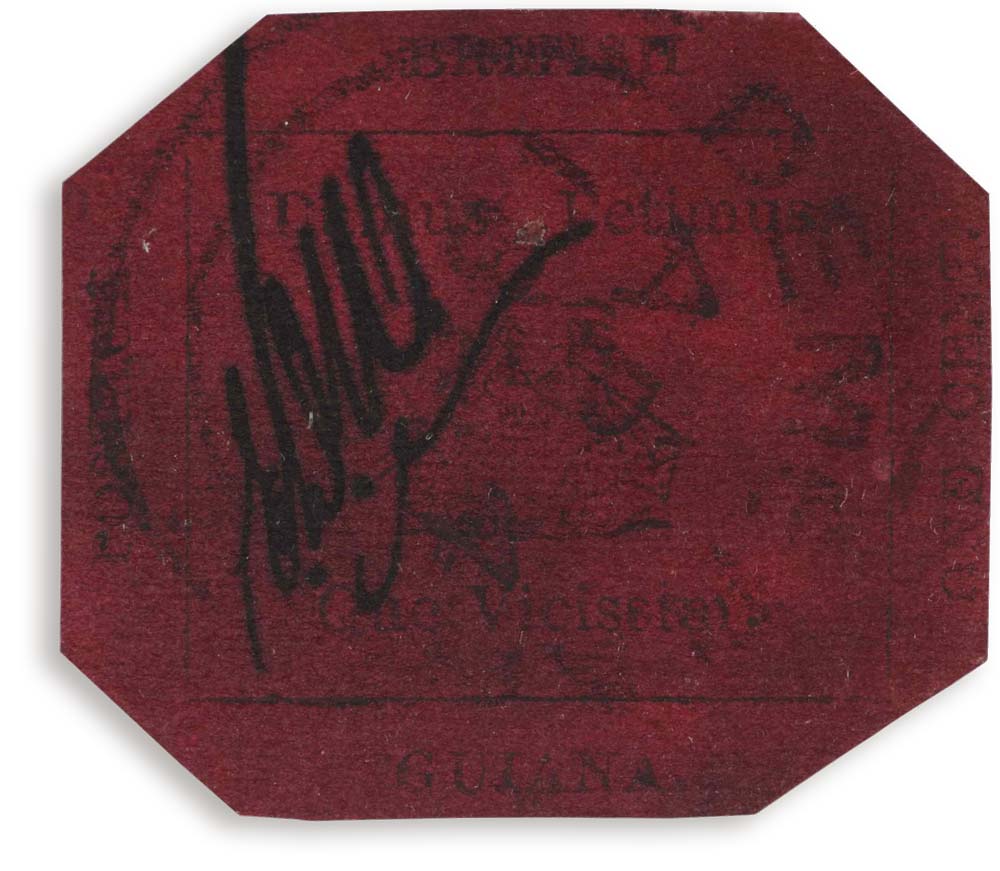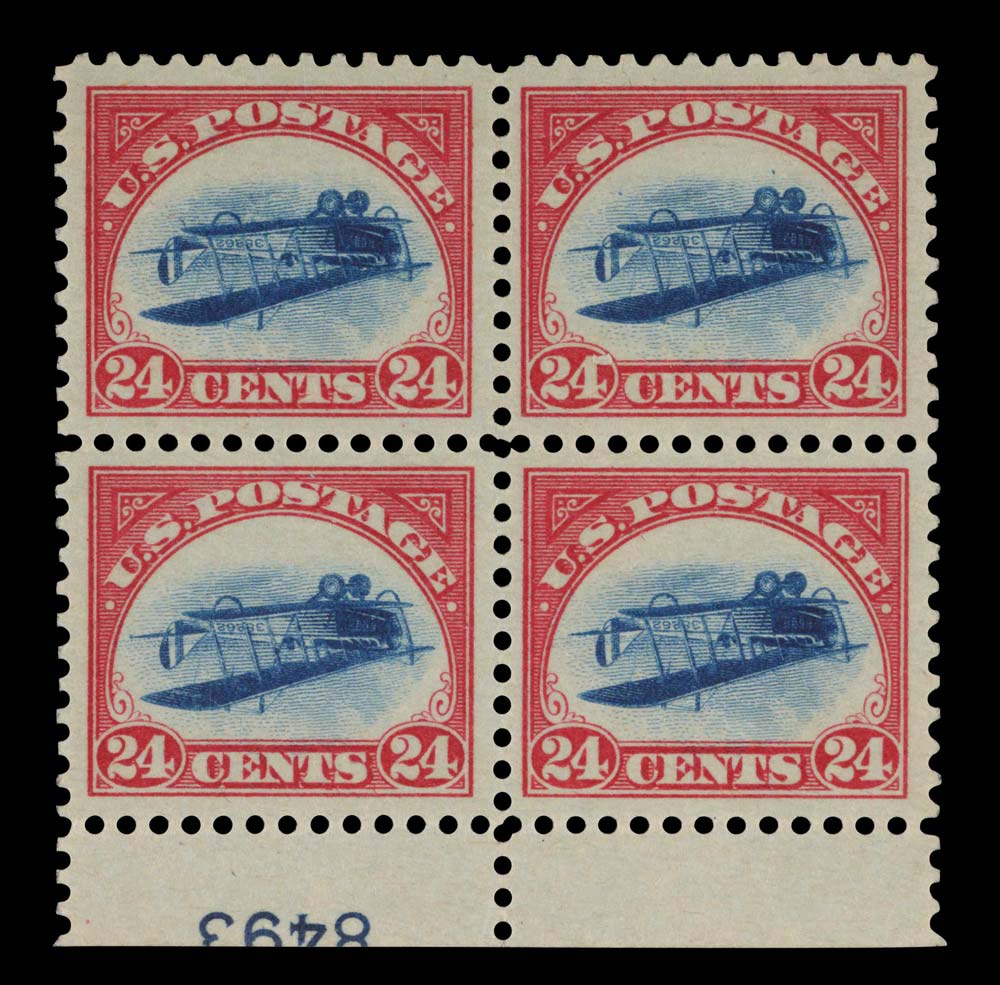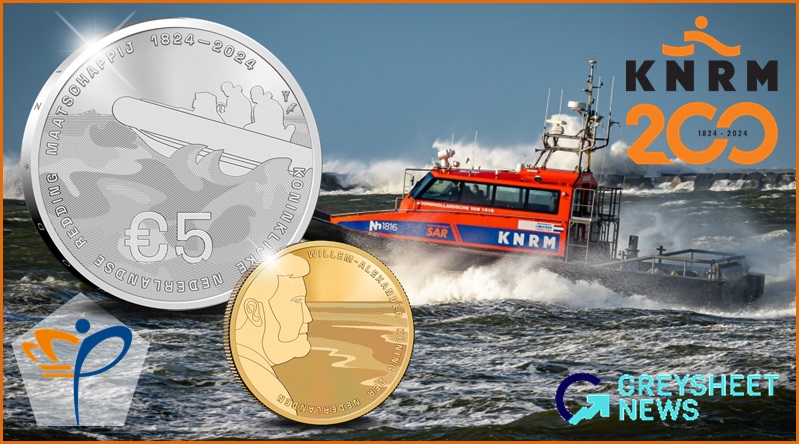Sotheby’s to Present Historic Auction of World's Most Legendary Coin & Stamp Specimens of Unrivaled Rarity, Value, Provenance & History
THREE TREASURES – COLLECTED BY STUART WEITZMAN
Includes:
THE WORLD’S MOST FAMOUS AND STORIED COIN
The Holy Grail of Coins: The Only 1933 Double Eagle That May Be Legally Owned
The Legendary and Unique British Guiana One-Cent Magenta
The Iconic 24-Cent Inverted Jenny Plate Block
Dedicated Exhibition to Open During New York Asia Week
NEW YORK, 10 March 2021 – Sotheby’s New York is pleased to present Three Treasures – Collected by Stuart Weitzman , a dedicated live auction of three legendary treasures from the personal collection of the renowned fashion designer and collector. On 8 June 2021 Sotheby’s will offer the fabled and elusive 1933 Double Eagle Coin, which set a world record when it last sold at auction in 2002, and the only example that is legally sanctioned by the United States government for private ownership; the sole-surviving example of the British Guiana One-Cent Magenta, the most famous and valuable stamp in the world; and The Inverted Jenny Plate Block, the most well-known and sought-after American stamp rarity. Iconic as they are rare, the Double Eagle and the British Guiana will be offered with estimates of $10/15 million each and are poised to set new world auction records in their respective categories, and the Inverted Jenny will carry an estimate of $5/7 million, set to eclipse its own record for an American philatelic item.
Richard Austin, Sotheby’s Global Head of Books & Manuscripts, commented: “As the most aspirational objects in their respective collecting fields and each with their own illustrious provenance, the Double Eagle, the British Guiana and the Inverted Jenny all hold an indelible place in history, and in our collective imagination. Each treasure is unique in its own right: the 1933 Double Eagle as the only legally owned example, the British Guiana as the only one known, and the Inverted Jenny as the only plate block from a unique sheet of stamps. It would be a true privilege to present just one of these sought-after rarities at auction but offering all three one-of-a-kind treasures together in the same sale is a once-in-a-lifetime occurrence. It is a testament to Stuart’s perennial passion and dedication to his childhood ambition of acquiring these prized pieces that we are able to create a special moment to share their stories with the world at once.”

Stuart Weitzman
Stuart Weitzman added: “I had a life-long dream of collecting the single greatest rarities in the two great collecting areas of stamps and coins and then placing these extraordinary treasures, hidden away for decades, on continuous public view. I determined to do that, and I did that. That was my dream. Today my dream is to leave a legacy of charitable works to which the proceeds from the sales of these treasures will go.”
The three treasures will be on public view by appointment in Sotheby’s York Avenue Galleries during New York Asia Week from 11 – 17 March as well as this May alongside the Contemporary and Impressionist Art exhibitions for our marquee spring auctions, and 5 – 7 June in the lead up to the auction on Tuesday, 8 June.
For more than 60 years, entrepreneur and philanthropist Stuart Weitzman pioneered luxury shoe design as founder of his eponymous company and is renowned for creating high-end shoes that are internationally beloved and synonymous with the pinnacle of luxury fashion design. In 2015, the Stuart Weitzman brand was acquired by Tapestry and remains one of the most highly sought-after luxury designers by celebrities and fashion lovers alike. Beyond his highly successful career in fashion, Weitzman is a life-long philatelist and numismatist with a deep appreciation for one-of-a-kind objects. Growing up collecting stamps and coins at an early age in Queens, New York, he fulfilled his boyhood pursuits at the highest echelon with his acquisition of the Double Eagle in 2002 and the British Guiana and Inverted Jenny Plate Block in 2014. Weitzman has been a generous steward of the three treasures, loaning the British Guiana to the Smithsonian National Postal Museum where it has been on public display since 2015 in its own special exhibition, as well as loaning the Double Eagle first to the Federal Reserve in Manhattan and then later to the New-York Historical Society Museum & Library. The Double Eagle has been exhibited at the New-York Historical Society Museum & Library since 2013 and was joined by the Inverted Jenny in 2014 following Weitzman’s acquisition of the plate block.
All of the seller’s proceeds will benefit charitable ventures, including The Weitzman Family Foundation, which supports medical research and higher education such as the Stuart Weitzman School of Design at the University of Pennsylvania. Other major Foundation projects include a museum in Madrid, the first of its kind, devoted to Spanish Judaica.

The 1933 Double Eagle
One of the rarest coins in the collecting field, the 1933 Double Eagle (estimate $10/15 million) twenty-dollar coin is completely unique in that it is the only one of its kind that may be legally owned by a private individual. When Weitzman anonymously purchased the coin at Sotheby’s New York in 2002 for $7.59 million, it established a new world auction record for any coin at the time, nearly doubling the previous record. The auction was conducted on behalf of the United States Government following a landmark legal settlement, which for the first and only time, authorized the private ownership of this 1933 Double Eagle alone. At the conclusion of the sale and in an historic moment, the Director of the United States Mint signed a Certificate of Monetization turning the coin into legal United States tender – the first time the United States Government had ever monetized a coin in this way.
The 1933 Double Eagle has a uniquely captivating history which encapsulates large swathes of United States history and has been at the center of numismatic intrigue for more than 70 years. Known as the coin that took the US off the Gold Standard, 1933 Double Eagles were the last American gold coins struck and intended for circulation by the United States Mint but were never legally issued for use. Designed by the renowned sculptor Augustus Saint-Gaudens at the behest of President Theodore Roosevelt, its imagery of Liberty striding forward on the obverse, with an American eagle in flight on the reverse marks the apex of United States coin design. In 1933 President Franklin Roosevelt took the country off the gold standard in an effort to lift America’s tattered economy out of the Great Depression. Since they were never officially issued for use, all 1933 Double Eagle coins were ordered to be destroyed with exception of two examples set aside for the Smithsonian Institution. In 1937, several 1933 Double Eagles appeared on the market, which led to a Secret Service investigation in 1944 that deemed all newly discovered coins were stolen from the United States government and therefore illegal to own.
However, only weeks before the Secret Service investigation began in 1944, one of the 1933 Double Eagles was purchased and erroneously granted an export license. It entered the famed coin collection of King Farouk where it remained until 1954 when his collection was offered at auction by Sotheby’s, acting on behalf of the new Republic of Egypt. Upon learning of its presence in the sale, the United States Treasury successfully requested that the coin be withdrawn and the whereabouts of the coin remained a mystery until 1996 when it was seized during a Secret Service sting at the Waldorf-Astoria in New York. Following a five-year legal battle, which unearthed the long-forgotten and erroneously issued export license, the case was settled, and this single 1933 Double Eagle was permitted to be privately owned.
In 2005, ten more 1933 Double Eagles surfaced in the possession of the family of one of the individuals investigated in the 1944 Secret Service investigation and another legal battle ensued. More than a decade later, after a jury trial and appeals (to as high as the Supreme Court), 1933 Double Eagles were ruled property of the United States and therefore, with the exception of Stuart Weitzman’s example, can never be sold (following the litigation another 1933 Double Eagle was voluntarily surrendered to the US government).

British Guiana One-Cent Magenta
No stamp is rarer than the sole-surviving example of the British Guiana One-Cent Magenta(estimate $10/15 million), a unique yet unassuming penny issue from 1856, which has been heralded as the pinnacle of stamp collecting for more than a century. Each of the four times it has sold at auction, it has established a new record price for a single stamp, last selling to Weitzman in 2014 at Sotheby’s for $9.48 million, nearly one billion times its original face value.
The British Guiana is equally notable for its legacy, having been rediscovered by a 12-year-old schoolboy living in South America in 1873, and from there passing through some of the most important stamp collections ever assembled. Its storied history starts in 1852, when British Guiana began receiving regular postage stamps manufactured in England by Waterlow & Sons; due to a clerical error in 1855, a shortage of the imported stamps threatened to disrupt the postal service throughout British Guiana and forced the postmaster to turn to the printers of the local Royal Gazette newspaper to commission a contingency supply of postage stamps for the following year: the one-cent black on magenta colored paper, a four-cent magenta, and a four-cent blue.
The sole-surviving example of the one-cent magenta was first rediscovered in 1873 when L. Vernon Vaughan, a 12-year-old schoolboy living with his family in British Guiana, found the stamp among a group of family papers bearing many British Guiana issues. A budding philatelist, Vaughan could not have known that the one-cent was unique, but he did know that he did not have an example and added it to his album. He would later sell the stamp for several shillings to another local collector.
The British Guiana then entered the UK in 1878, and shortly after, it was purchased in Paris by Count Philippe la Renotière von Ferrary, perhaps the greatest stamp collector in history. Following the war, France seized his collection, which had been donated to the Postmuseum in Berlin, as part of war reparations due from Germany, and sold the stamp in 1922 as one of a series of celebrated auctions from 1921–25. It was bought by Arthur Hind, a textile magnate from New York, for its first auction-record price of $35,000, followed by: Australian engineer Frederick T. Small; then a consortium headed by Irwin Weinberg; then by John du Pont, heir to the eponymous chemical company fortune, eccentric amateur sportsman, and avid collector. Du Pont paid $935,000 for the stamp in a 1980 auction, before it was last sold at auction to Weitzman, marking the object’s most recent record-setting price of $9.48 million. Carrying on the tradition of previous owners of the British Guiana, Weitzman added his own personal mark to the reverse of the stamp this past October, inscribing his initials “SW” along with a line drawing of a stiletto shoe as a nod to his legacy in fashion.

24-Cent Inverted Jenny Plate Block
The first United States airmail issue and the most highly recognized and sought-after philatelic error, the 1918 24-Cent Inverted Jenny Plate Block (estimate $5/7 million) is the most famous and valuable item in United States stamp collecting. There was only one sheet of 100 Inverted Jennies ever sold, and only one plate block comprising positions 87-88 and 97-98. It last appeared on the market 16 years ago when it sold at auction for $2.97 million and was subsequently purchased privately by Weitzman in 2014.
To pay the designated 24 cent rate for the new official airmail route, the United States Postal Service released a special bi-colored stamp in May 1918 featuring a blue Curtiss JN-4 “Jenny” biplane – the country’s first airmail carrier – surrounded by a carmine red frame. A single sheet of 100 stamps with the biplanes appearing upside-down – due to a printing error – was sold for $24, the face value of the 100 stamps, to William T. Robey. A cashier at a stock brokerage firm and an astute stamp collector, Robey recognized the rarity of the flawed sheet and rebuffed the USPS demands that he return the stamps after they learned of their mistake. Instead he sold the sheet just a few days later marking the beginning of the wild and sinuous journey of the 100 Inverted Jennies, which encompasses some of the greatest stories in American stamp history.
Having rapidly gained notoriety within the philatelic community, Eugene Klein – the Philadelphia stamp dealer who purchased the sheet from Robey – immediately sold it to the multi-millionaire Colonel “Ned” Green, a wildly eccentric stamp and coin collector. Klein later persuaded Green to allow him to sell individual stamps to eager collectors, requiring him to carefully break the sheet into singles and blocks which he did after discreetly, and astutely, numbering every stamp in light pencil on the reverse. The Colonel retained numerous singles and all the major blocks – including the present plate number block, which then comprised eight examples. Following Green’s death in 1944, the block of eight Jennies passed into the collection of Amos Eno where it was separated into a block of four and ten years later it was purchased by the Weill Brothers of New Orleans, beginning an association that was to last for thirty-five years. Described as “The most important item in United States philately” when the Weill Brothers stock came to auction in 1989, it was bought for the unprecedented sum of $1.1 million by an anonymous buyer who kept the block until 2005 when famed bond investor William Gross purchased it for $2.97 million.

Download the Greysheet app for access to pricing, news, events and your subscriptions.
Subscribe Now.

Subscribe to Monthly Greysheet for the industry's most respected pricing and to read more articles just like this.
Source: CDN Publishing











